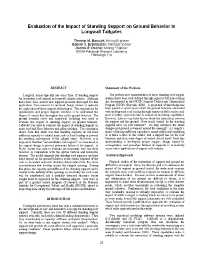Mining Publication: Evaluation of the Impact of Standing Support on Ground Behavior in Longwall Tailgates
Original creation date: August 2005
Longwall mines typically use some form of standing support for secondary roof support in longwall tailgate entries. Although there have been several new support products developed for this application, there remains no universal design criteria to optimize the application of these support technologies. The requirement for optimization and proper support selection is to understand the degree of control that the support has on the ground behavior. The ground reaction curve and numerical modeling was used to evaluate the impact of standing support on ground behavior. LaModel was used to evaluate the impact of standing support on main roof and floor behavior and pillar yielding. The conclusion drawn from this study was that standing supports do not have sufficient capacity to control main roof or floor loading or prevent the resulting convergence of the tailgate entry. However, it is imperative that this "uncontrollable convergence" be considered in the support design to prevent premature failure of the support. A FLAC model was used to evaluate the near-seam roof and floor behavior in conjunction with the global vertical and horizontal stresses. The model suggests that standing roof supports can have some impact on the ground behavior as the elastic response of the rock is exceeded and rock structure deteriorates from the stress concentrations that develop around the tailgate opening. During this phase, the capacity and stiffness of the standing support can be critical to the stability of the opening, as eventually the rock mass will be transformed into a partially detached structure whose weight must be supported by the standing support. This work is part of a ground control program of research at the National Institute for Occupational Safety and Health (NIOSH) aimed at improving mine safety by reducing roof fall injuries and fatalities.
Authors: TM Barczak, GS Esterhuizen, DR Dolinar
Conference Paper - August 2005
NIOSHTIC2 Number: 20028260
In: Peng SS, Mark C, Finfinger GL, Tadolini SC, Heasley KA, Khair AW, eds. Proceedings of the 24th International Conference on Ground Control in Mining. Morgantown, West Virginia, August 2-4, 2005. Morgantown, WV: West Virginia University, 2005; :23-32
See Also
- Analysis of the Interaction Between Mobile Roof Supports and Mine Strata
- Behavior of a Coal Pillar Prone to Burst in the Southern Appalachian Basin of the United States
- Case History of the Response of a Longwall Entry Subjected to Concentrated Horizontal Stress
- Coal Bumps and Odd Dynamic Phenomena - A Numerical Investigation
- Degasification System Selection for U.S. Longwall Mines Using an Expert Classification System
- Empirical Guidelines for Longwall Ground Control Design
- A First Step in Developing Roof Support Design Criteria Based on Ground Reaction Data for Pittsburgh Seam Longwall Tailgate Support
- Overview of Coal Mine Ground Control Issues in the Illinois Basin
- Pumpable Roof Supports: Developing Design Criteria by Measurement of the Ground Reaction Curve
- Updating the NIOSH Support Technology Optimization Program (STOP) With New Support Technologies and Additional Design Features
- Page last reviewed: 9/21/2012
- Page last updated: 9/21/2012
- Content source: National Institute for Occupational Safety and Health, Mining Program


 ShareCompartir
ShareCompartir
